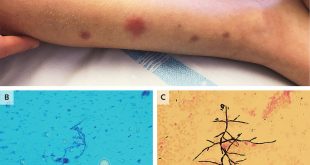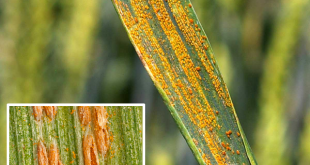ا. د. محمد المليجي
 في بحث فريد نشر منذ أسبوع في أحد الدوريات الطبية لأهميته في صحة الإنسان وصحة النبات كشف عالم أمراض نبات من كلية الزراعة والعلوم البيئية – قسم أمراض النبات – جامعة كاليفولرنيا ديفز عن بروتين معين تفرزه البكتيريا لتنظم هجومها الجماعي على خلايانا او خلايا النبات وهذا البروتين يصدر إشارات يلتقطها النبات ليعمل سريعا على أن يدافع عن نفسه.ووسائل دفاع النبات عن نفسه عديدة بعضها سريه الأثر وبعضها بطيء وبعضها كيمائي
في بحث فريد نشر منذ أسبوع في أحد الدوريات الطبية لأهميته في صحة الإنسان وصحة النبات كشف عالم أمراض نبات من كلية الزراعة والعلوم البيئية – قسم أمراض النبات – جامعة كاليفولرنيا ديفز عن بروتين معين تفرزه البكتيريا لتنظم هجومها الجماعي على خلايانا او خلايا النبات وهذا البروتين يصدر إشارات يلتقطها النبات ليعمل سريعا على أن يدافع عن نفسه.ووسائل دفاع النبات عن نفسه عديدة بعضها سريه الأثر وبعضها بطيء وبعضها كيمائي
وبعضها عضوي او ميكانيكي و تفاصيل هذا الموضوع طويلة يعرفها طلبة الدراسات العليا والباحثين المتخصصين في أمراض النبات، أما سبب اللإهتمام العالمي بهذا البحث في أمراض النبات فهو لأنه أول ترجمة عملية او دليل مادي على ما كنا نعرفه منذ عشرون عاما من وجود وسائل للتخاطب بين الكائنات الدقيقة والنباتات من نفس النوع ولكن لم يتوفر لنا دائما دليل مادي على ذلك، أما كيف سيفيد ذلك اليشرية فهو لأنه لو عرفنا جيدا هذا البروتين الذي هو لغة التخاطب كان في إمكاننا أن نتدخل ضد البكتيريا الممرضي بوسيلتين الأولي أن نعطل عمل هذا البروتين فلا تستطيع البكتيريا ان تنسق هجومها علينا او على نباتاتنا والثانية هي اننا قد نصنع هذا البروتين ونستخدمه كمحفز لتنشيط المقاومة ضد البكتيريا في الجسم الحي، ولا شك أن هذا الكشف سيقودنا الى بحوث واكتشافات أخري
Tiny protein helps bacteria ‘talk’ and triggers defensive response in plants
University of California, Davis
December 13, 2011
Scientists have discovered a new signal that helps invading bacteria communicate but also helps targeted rice plants coordinate defensive attacks on the disease-causing invaders, a finding that could lead to new methods of combating infection not just in plants, but in humans.
Findings from the study, conducted by a team of researchers led by a University of California, Davis, scientist, are reported today in the journal PLoS ONE and in the journal Discovery Medicine at <http://www.discoverymedicine.com/>.
“Just as invading armies often use coded messages to coordinate attacks on their targets, so single-celled bacteria use biological signals to communicate when they attack plants and animals,” said Pamela Ronald, a UC Davis professor of plant pathology and the lead researcher on the study. “Scientists have known this for 20 years, however results from our study reveal a type of bacterial signal that has never been described before.”
Ronald has posted an article about the study on her blog, “Tomorrow’s Table,” at <http://scienceblogs.com/tomorrowstable>.
UC Davis has a long history of tackling agricultural and environmental challenges related to rice production in the United States and around the world. Today, campus researchers are using molecular biology to better understand how to improve the hardiness and yield of this grain, which is a staple food for more than half of the world’s population and an important model for plant research.
Up until now, scientists thought that two major groups of bacteria used two distinctly different types of communication codes, Ronald said. However Ax21, the small protein examined in this study, doesn’t fit into either of those previously identified communication codes.
Ax21 is made inside the bacterial cell and processed to generate a shorter signal that is secreted outside the bacterium. This signal tips off other bacteria to assemble themselves into elaborate protective bunkers, called biofilms, which make the bacteria resistant to drying out and antibiotic treatment.
“Additionally, Ax21 triggers a change in the expression of nearly 500 bacterial genes, transforming the bacteria from fairly benign organisms into fierce invaders,” Ronald said.
“In essence, through communication and communal living, the bacteria increase their chances of survival and proliferation,” she said, noting that in rice, the bacteria multiply rapidly in the arteries that transport water, causing the plant to wither and die.
While most rice plants have little defense against the Ax21-mediated bacterial attack, some rice plants carry an immune receptor called XA21 that detects the Ax21 protein produced by the invading bacteria. XA21 belongs to a large class of immune receptors in plants and animals.
The importance of these receptors in immunity is reflected in the awarding of the 2011 Nobel Prize in physiology and medicine to researchers Bruce Beutler of The Scripps Research Institute in La Jolla <http://www.nobelprize.org/mediaplayer/index.php?id=1733> and Jules Hoffman of the National Center of Scientific Research in Strasbourg, France, for their discoveries of similar receptors in animals. (Interestingly, Ronald and Beutler are related, as described in an article in The Scientist magazine at <http://the-scientist.com/2011/04/01/family-affair/>. Their fathers, Ernst Beutler and Robert Rosenthal, were cousins in Berlin. The two families escaped the Nazis in the 1930s and reunited in the United States after the war.)
The new study points out that the Ax21 signaling protein triggers the XA21 immune receptor to biologically alert the plant to launch a powerful defense response against the invading bacteria. The researchers also demonstrated that Ax21 is present in a human disease-causing bacterium that is known to infect hospital patients.
“This study demonstrates that bacteria communicate using private messages. However, plants can intercept these messages and gain a tactical advantage in the evolutionary battle,” Ronald said.” It’s a fascinating story.”
Researchers collaborating on the study are from UC Davis and Kyung Hee University, Korea.
Funding for the study was provided by the U.S. Department of Agriculture and the National Institutes of Health.
For more information please see: http://scienceblogs.com/tomorrowstable/2011/12/lets_talk_a_story_of_interspec.php
EarthSky podcast: http://earthsky.org/health/pamela-ronald-on-breaking-bacteria’s-code
 صحة النبات – Plant Health كل مايخص امراض وصحة النبات
صحة النبات – Plant Health كل مايخص امراض وصحة النبات





